Intumescent Coatings for Fire Resistance of Steel Structures: Current Approaches for Qualification and Design
Abstract
:1. Introduction
2. IC Technical Solution
3. Qualification Process
3.1. National Qualification Process
3.2. European Qualification Process
| No. | Essential Characteristic | Assessment Method |
|---|---|---|
| Basic Work Requirement 2: Safety in case of fire | ||
| 1 | Reaction to fire | Test methods and classification according to EN 13501-1 [20] |
| 2 | Resistance to fire | Test methods and classification according to EN 13501-2 [21] |
| Basic Work Requirement 3: Hygiene, health, and the environment | ||
| 3 | Content, emission, and/or release of dangerous substances | SVOCs and VOCs according to EN 16516 |
| Basic Work Requirement 4: Safety and accessibility in use | ||
| 4 | Adhesion | Insulating efficiency tests according to EN 1363-1 |
| 5 | Durability | Insulating efficiency tests on initial and exposed specimens according to EN 1363-1 |
- IA1: Product with direct contact to indoor air;
- IA2: Product with indirect contact to indoor air but possible impact on indoor air;
- S/W2: Product with indirect contact soil, ground, and surface water.
4. Design and Control of the Application: Overview of Available Codes
4.1. Design and Verification Methods with a Prescriptive-Based Approach
- dIC = dry film thickness of reactive product, in meters;
- V/Ap = inverse of the steel section factor, in meters;
- ca = temperature-dependent specific heat capacity of steel at θa, in J/kgK;
- ρa = density of the steel, in kg/m3;
- θt = furnace temperature, in Celsius degrees;
- θa,t = steel temperature, in Celsius degrees;
- Δt = time step, in seconds;
- Δθa,t = steel temperature increase over time step Δt, in Kelvin degrees.
4.2. Design and Verification Methods with a Performance-Based Approach
4.3. Control of IC Application
- Step (a)—surface preparation: to guarantee the bond between the dolly and the coating, degrease the dolly and the area of the coating to be tested using alcohol or acetone to remove any oil, moisture, or dust;
- Step (b)—application of adhesive: It must have cohesive and fixing properties greater than those of the coating under test in order to obtain a failing of the coating. The dolly should be gently pushed down to squeeze out excess adhesive and remove it from around the edges of the dolly (Figure 14). Finally, wait the necessary time for the adhesive to dry;
- Step (c)—separation of test area: after the adhesive dries, before starting the test, the paint around the dolly should be removed to isolate a specific diameter test area. Generally, a drill with a diameter approximately 1 mm larger than the diameter of the dolly can be used;
- Step (d)—load application: The contact between the dolly and the actuator should be carefully checked (Figure 14). The force must be applied perpendicularly to the plane of the coated support at a uniform speed, less than approximately 1 MPa/s.
5. Conclusions
- -
- The data provided by manufacturers allow for application on only a prescriptive-based approach, obtaining, trough tabular data, the IC thickness necessary for a given structural element to reach a required fire resistance time;
- -
- Generally, no information is provided about the thermal properties of these materials;
- -
- According to EN 13381-8, a variable thermal conductivity can be calculated starting from the experimental results, allowing to assess the behaviour of the protected steel elements using both simplified and advanced calculation methods if the ISO834 curve is used;
- -
- The voluntary application regulations describing the control of intumescent coating application are often ignored and not applied.
Funding
Institutional Review Board Statement
Informed Consent Statement
Data Availability Statement
Conflicts of Interest
References
- Beh, J.H.; Yew, M.C.; Saw, L.H.; Yew, M.K. Fire Resistance and Mechanical Properties of Intumescent Coating Using Novel BioAsh for Steel. Coatings 2020, 10, 1117. [Google Scholar] [CrossRef]
- Lucherini, A.; Maluk, C. Intumescent coatings used for the fire-safe design of steel structures: A review. J. Constr. Steel Res. 2019, 162, 105712. [Google Scholar] [CrossRef]
- An Overview of Intumescent Coatings. American Coating Association. Available online: https://www.paint.org/coatingstech-magazine/articles/overview-intumescent-coatings/ (accessed on 18 April 2022).
- Hernandez, V.; Romero, R.; Arias, S.; Contreras, D. A Novel Method for Calcium Carbonate Deposition in Wood That Increases Carbon Dioxide Concentration and Fire Resistance. Coatings 2022, 12, 72. [Google Scholar] [CrossRef]
- Luhar, S.; Nicolaides, D.; Luhar, I. Fire Resistance Behaviour of Geopolymer Concrete: An Overview. Buildings 2021, 11, 82. [Google Scholar] [CrossRef]
- Norme Tecniche per le Costruzioni—NTC2018; Decreto del 17 Gennaio 2018; Gazzetta Ufficiale n. 42 del 20 Febbraio 2018. (In Italian). Available online: https://www.gazzettaufficiale.it/eli/gu/2018/02/20/42/so/8/sg/pdf (accessed on 18 April 2022).
- Construction Products Regulation (CPR)—Regulation (EU) No 305/2011 of the European Parliament and of the Council of 9 March 2011; Official Journal of the European Union. Available online: https://eur-lex.europa.eu/legal-content/EN/TXT/PDF/?uri=CELEX:32011R0305&rid=2 (accessed on 18 April 2022).
- EN 13381-8; Test Methods for Determining the Contribution to the Fire Resistance of Structural Members—Part 8: Applied Reactive Protection to Steel Members. European Committee for Standardization: Brussels, Belgium. Available online: https://standards.iteh.ai/catalog/standards/cen/df0cdd6b-9ef2-47fc-874b-414ae34aa5cc/en-13381-8-2013 (accessed on 18 April 2022).
- Qualificazione di Resistenza al Fuoco di Protettivi da Applicare ad Elementi in Acciaio; Lettera Circolare n°17381 of 2013; Ministero dell’interno–Dipartimento dei Vigili del Fuoco, del Soccorso Pubblico e Della Difesa Civile. Direzione Centrale per la Prevenzione e la Sicurezza Tecnica–Area Protezione Passiva: Rome, Italy, 2013. (In Italian)
- EAD 350402-00-1106; Reactive Coatings for Fire Protection of Steel Elements. EOTA: Brussels, Belgium, 2017.
- ETAG 018; Part 2. Guideline for European Technical Approval of Fire Protective Products. Part 2: Reactive Coatings for Fire Protection of Steel Elements. EOTA: Brussels, Belgium, 2006.
- Bourbigot, S.; Bras, M.L.; Dabrowski, F.; Gilman, J.W.; Kashiwagi, T. PA-6 clay nanocomposite hybrid as char forming agent in intumescent formulations. Fire Mater. 2000, 24, 201–208. [Google Scholar] [CrossRef]
- Kang, S.; Kwon, M.; Choi, J.Y.; Choi, S. Thermal Boundaries in Cone Calorimetry Testing. Coatings 2019, 9, 629. [Google Scholar] [CrossRef] [Green Version]
- Andersen, J. Experimental Study of the Thermal Resistance of Intumescent Coatings Exposed to Different Heating Rates. Master’s Thesis, Civil Engineering Department, Technical University of Denmark, Copenhagen, Denmark, 2015. [Google Scholar]
- De Silva, D.; Bilotta, A.; Nigro, E. Experimental investigation on steel elements protected with intumescent coating. Constr. Build. Mater. 2019, 205, 232–244. [Google Scholar] [CrossRef]
- EN 1363-1; Fire Resistance Tests—Part 1: General Requirements. CEN-CENELEC Management Centre: Brussels, Belgium, 2020.
- De Silva, D.; Bilotta, A.; Nigro, E. Effect of the thermal input on the behavior of intumescent coatings. In Proceedings of the International Conference of Applications of Structural Fire Engineering, Manchester, UK, 7–8 September 2017; pp. 325–334. [Google Scholar]
- EN 1993-1-2; Eurocode 3: Design of Steel Structures—Part 1–2: General Rules-Structural Fire Design. CEN-CENELEC Management Centre: Brussels, Belgium, 2005.
- EN 1994-1-2; Eurocode 4—Design of composite steel and concrete structures—Part 1–2: General rules-Structural Fire Design. CEN-CENELEC Management Centre: Brussels, Belgium, 2005.
- EN 13501-1; Fire Classification of Construction Products and Building Elements—Part 1: Classification Using Test Data from Reaction Fire Tests. CEN-CENELEC Management Centre: Brussels, Belgium, 2018.
- EN 13501-2; Fire Classification of Construction Products and Building Elements—Part 1: Classification Using Test Data from Resistance Fire Tests. CEN-CENELEC Management Centre: Brussels, Belgium, 2016.
- EN 13823; Reaction to Fire Tests for Building Products—Building Products Excluding Floorings Exposed to the Thermal Attack by a Single Burning Item. CEN-CENELEC Management Centre: Brussels, Belgium, 2020.
- EN ISO 11925-2; Reaction to Fire Tests—Part 2: Ignitability of Products Subjected to Direct Impingement of Flame. ISO: Brussels, Belgium, 2020.
- EN 16516; Construction Products—Assessment of Release of Dangerous Substances–Determination of Emissions into Indoor Air. CEN-CENELEC Management Centre: Brussels, Belgium, 2017.
- De Silva, D.; Alam, N.; Nadjai, A.; Nigro, E.; Ali, F. Finite Element Modelling for Structural Performance of Slim Floors in Fire and Influence of Protection Materials. Appl. Sci. 2021, 11, 11291. [Google Scholar] [CrossRef]
- De Silva, D.; Bilotta, A.; Nigro, E. Approach for modelling thermal properties of intumescent coating applied on steel members. Fire Saf. J. 2020, 116, 103200. [Google Scholar] [CrossRef]
- Zhang, C.; Li, G.Q.; Wang, Y.-C. Probabilistic analysis of steel columns protected by intumescent coatings subjected to natural fires. Struct. Saf. 2014, 5, 16–26. [Google Scholar] [CrossRef]
- Lucherini, A.; Giuliani, L.; Jomaas, G. Experimental study of the performance of intumescent coatings exposed to standard and non-standard fire conditions. Fire Saf. J. 2018, 95, 42–50. [Google Scholar] [CrossRef] [Green Version]
- Circolare DCPREV 9962 del 24/07/2020—Implementazione di Soluzioni Alternative di Resistenza al Fuoco; Chiarimenti e Indirizzi Applicativi; Ministero dell’interno—Dipartimento dei Vigili del Fuoco, del Soccorso Pubblico e Della Difesa Civile. Direzione Centrale per la Prevenzione e la Sicurezza Tecnica,–Area Protezione Passiva: Rome, Italy, 2020. (In Italian)
- UNI 10898-1; Fire Proofing Systems—Inspection Modes for the Installation—Part 1: Intumescent Coating. UNI: Milano, Italy, 2012.
- EN 2808; Paint and Varnishes—Determination of Film Thickness. CEN-CENELEC Management Centre: Brussels, Belgium, 2007.
- EN ISO 4624; Paint and Varnishes—Pull-Off Test for Adhesion. CEN-CENELEC Management Centre: Brussels, Belgium, 2006.


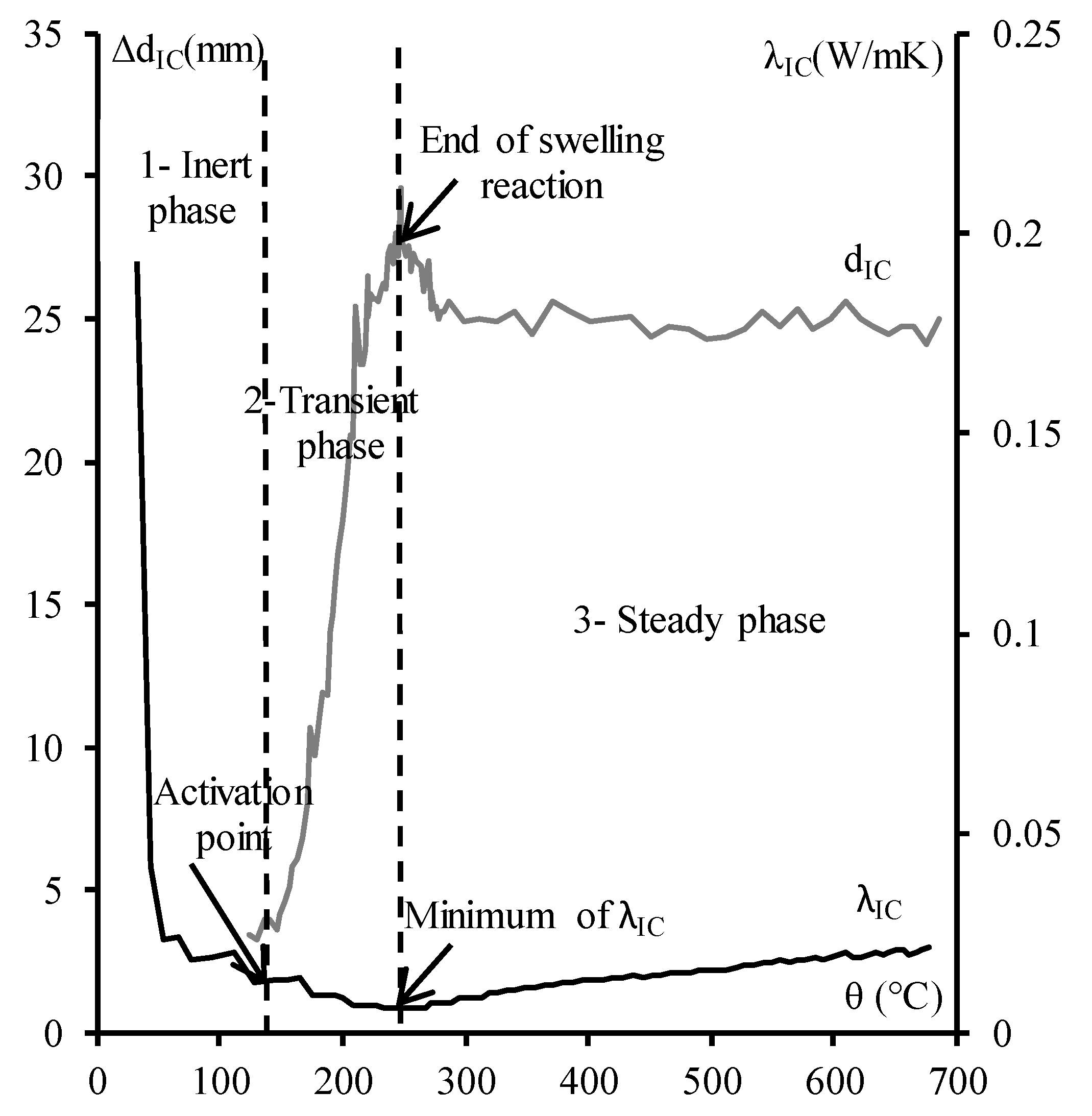


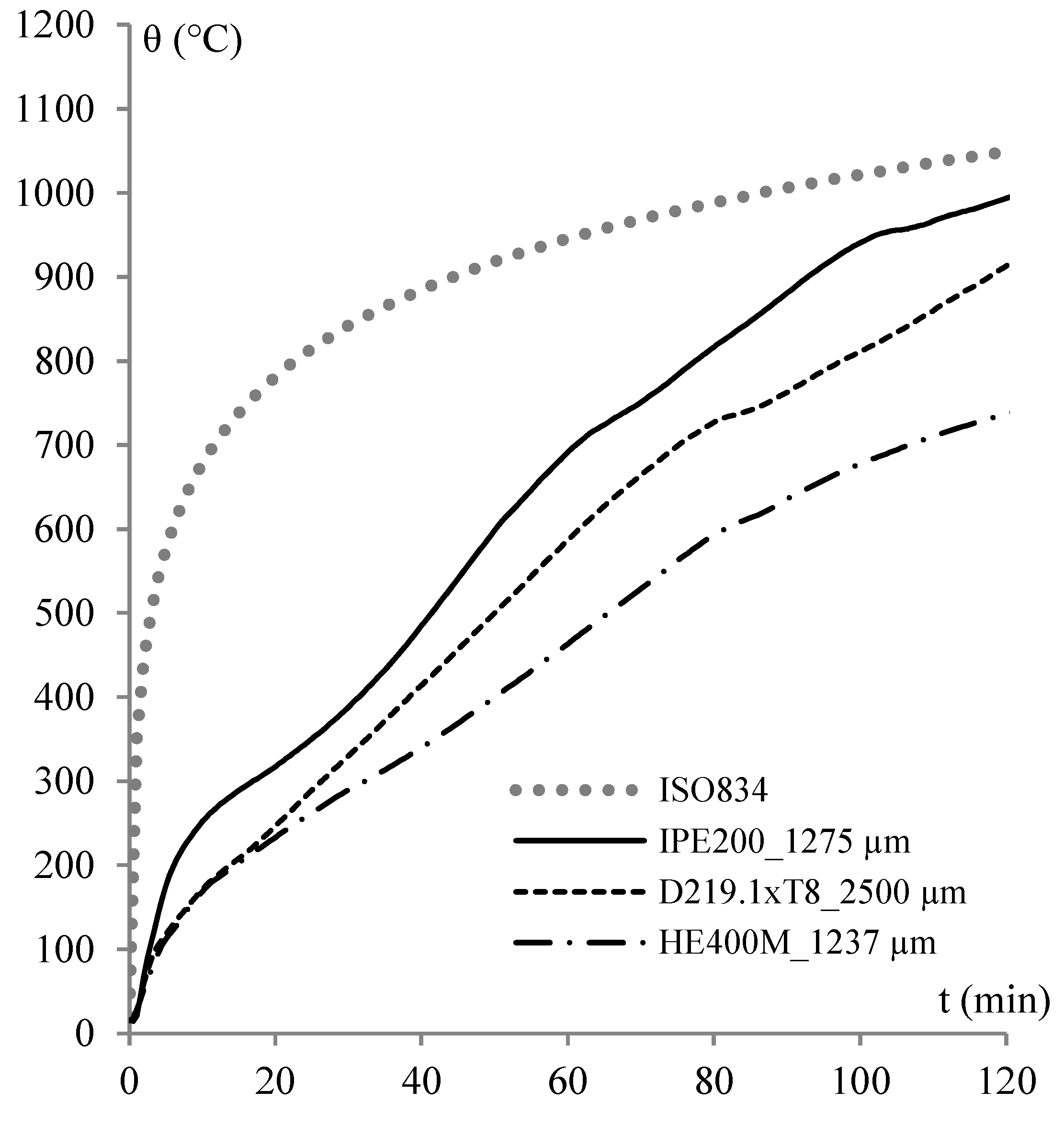
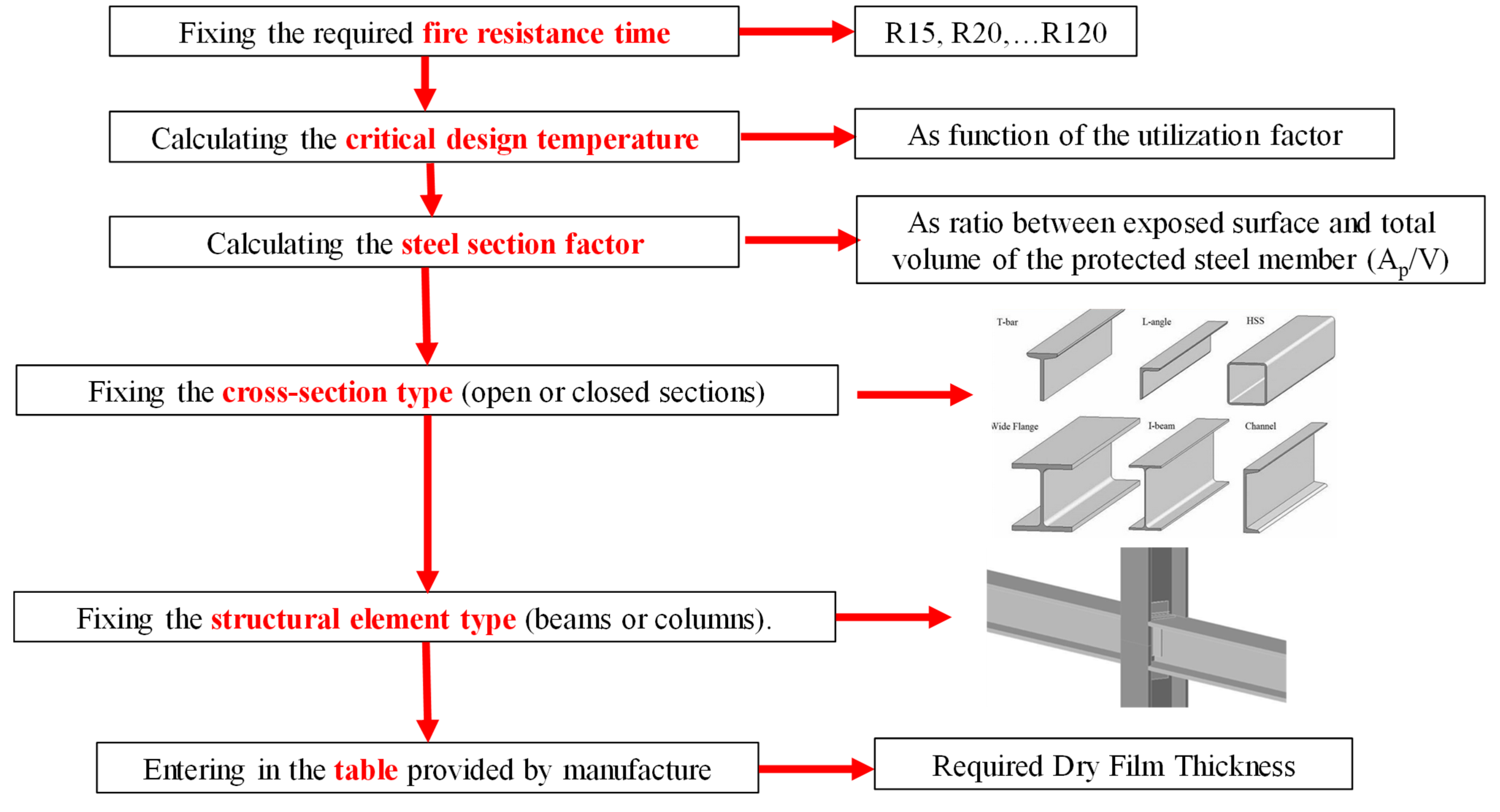
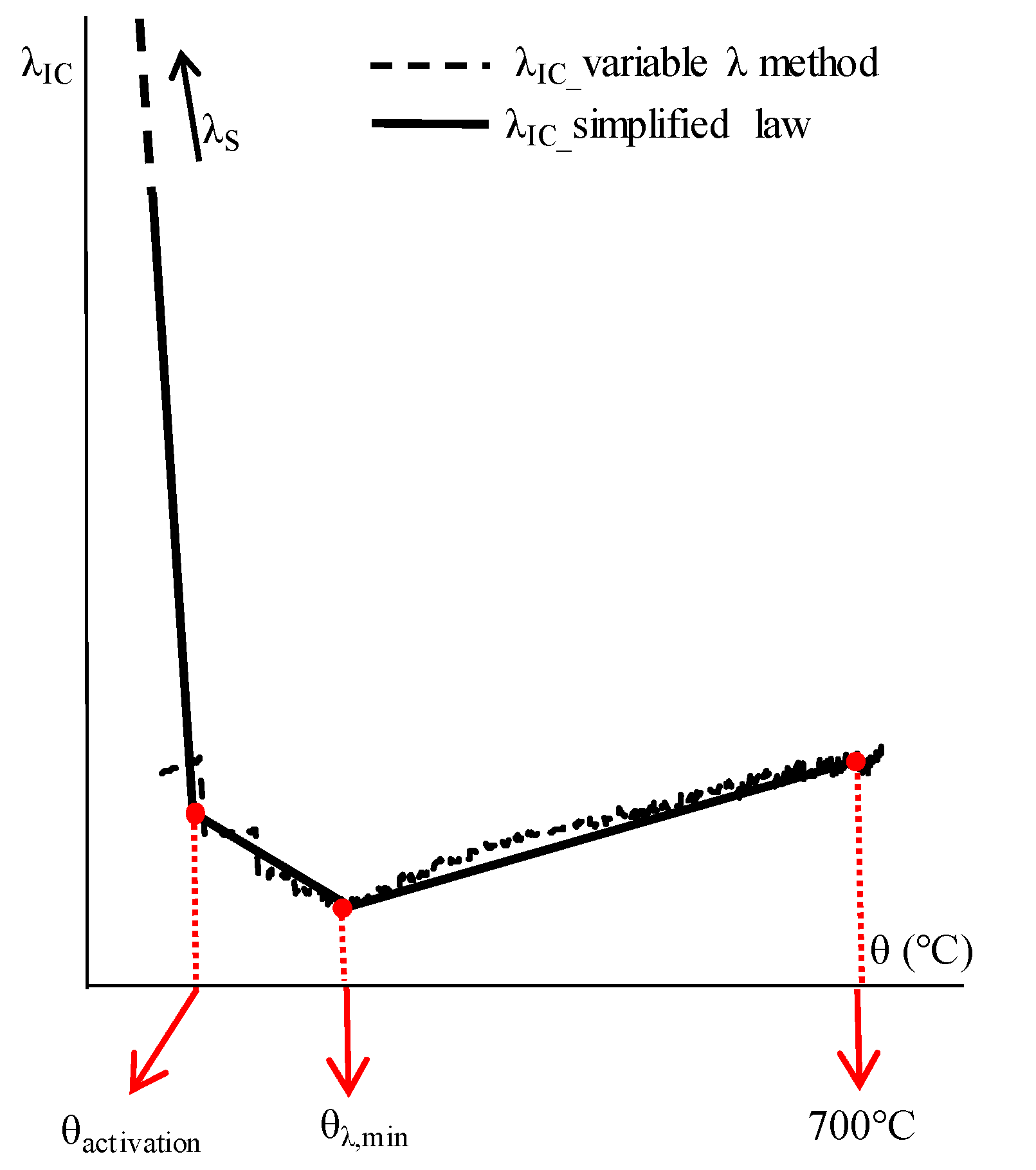
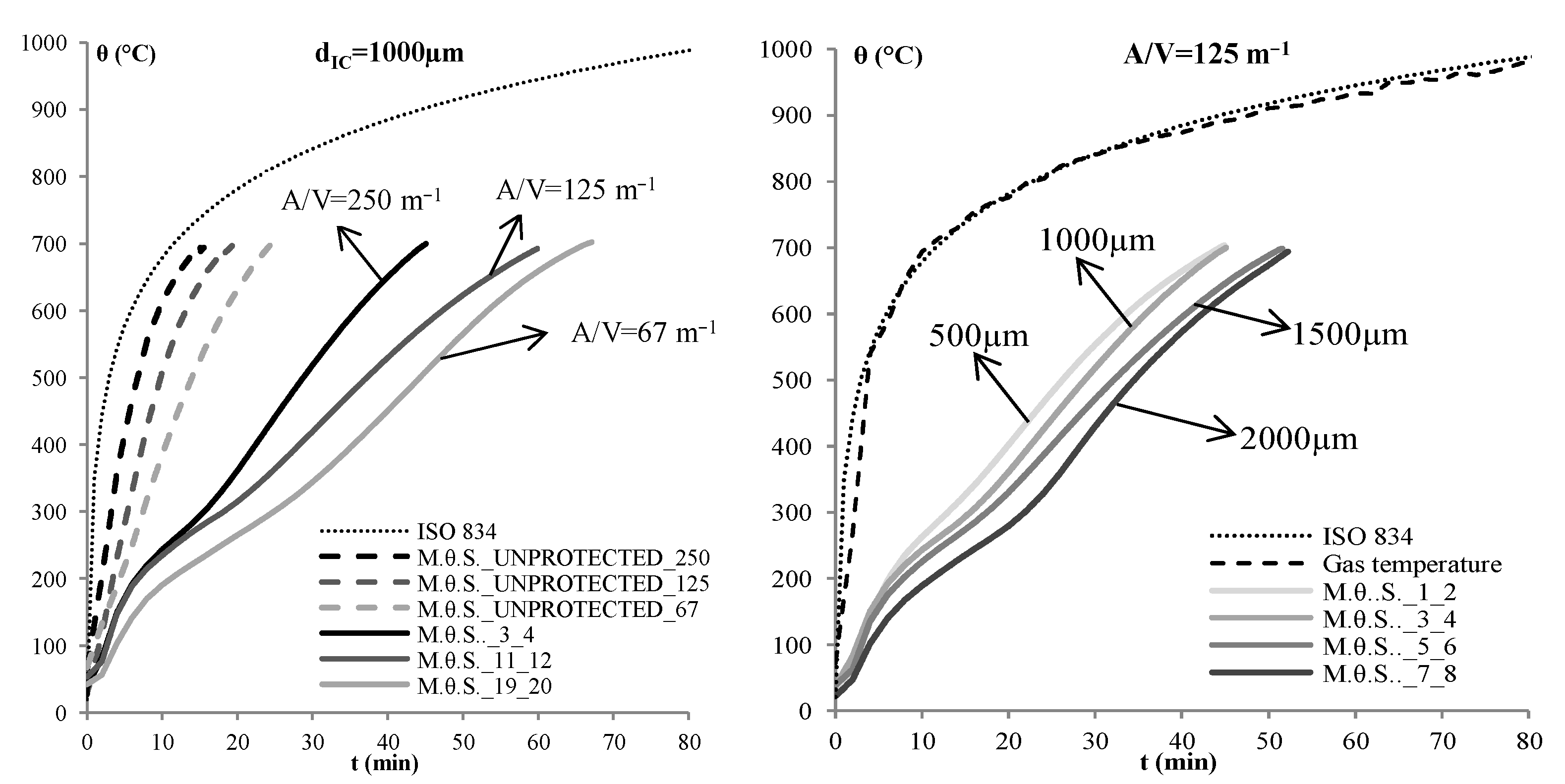
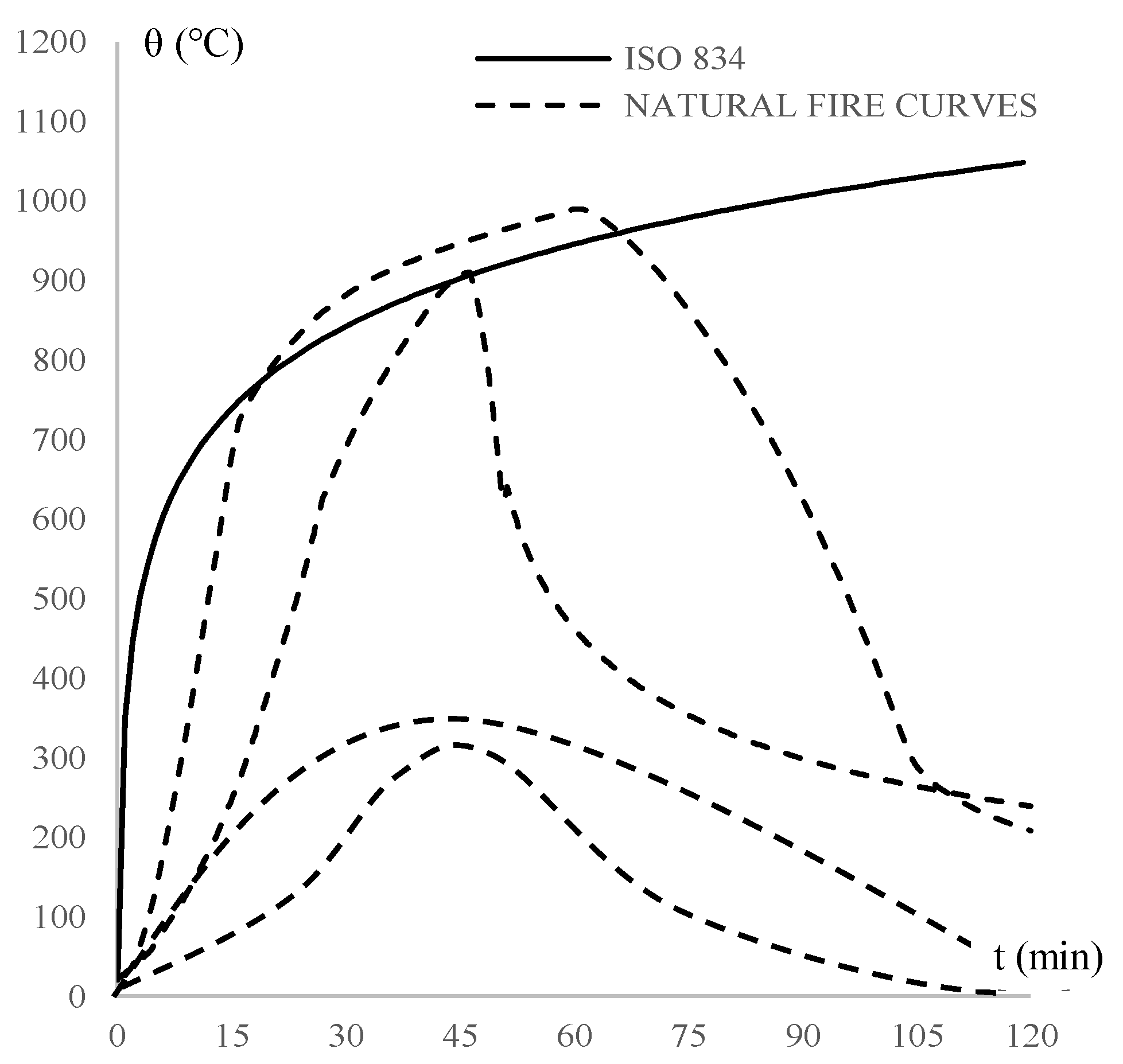

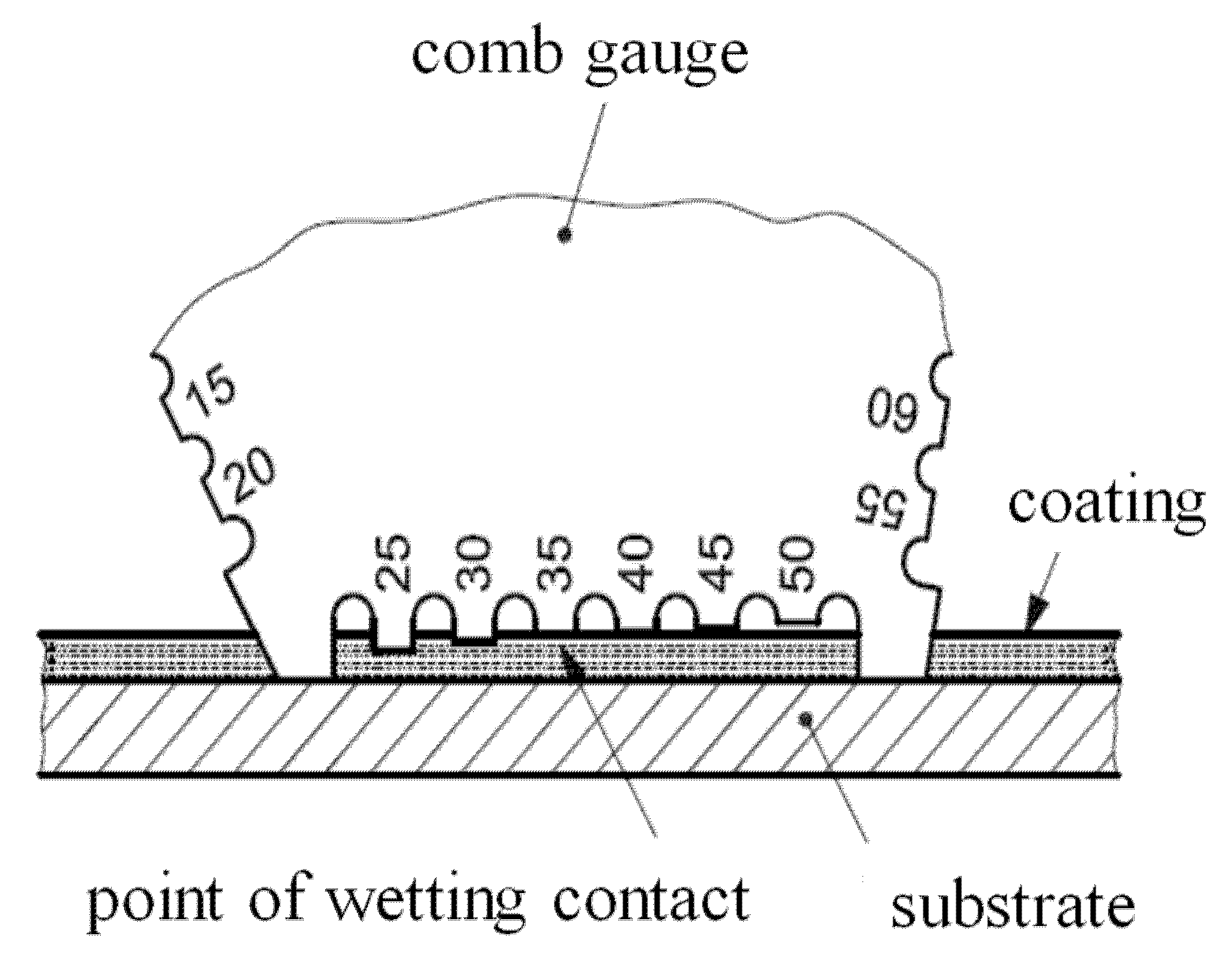

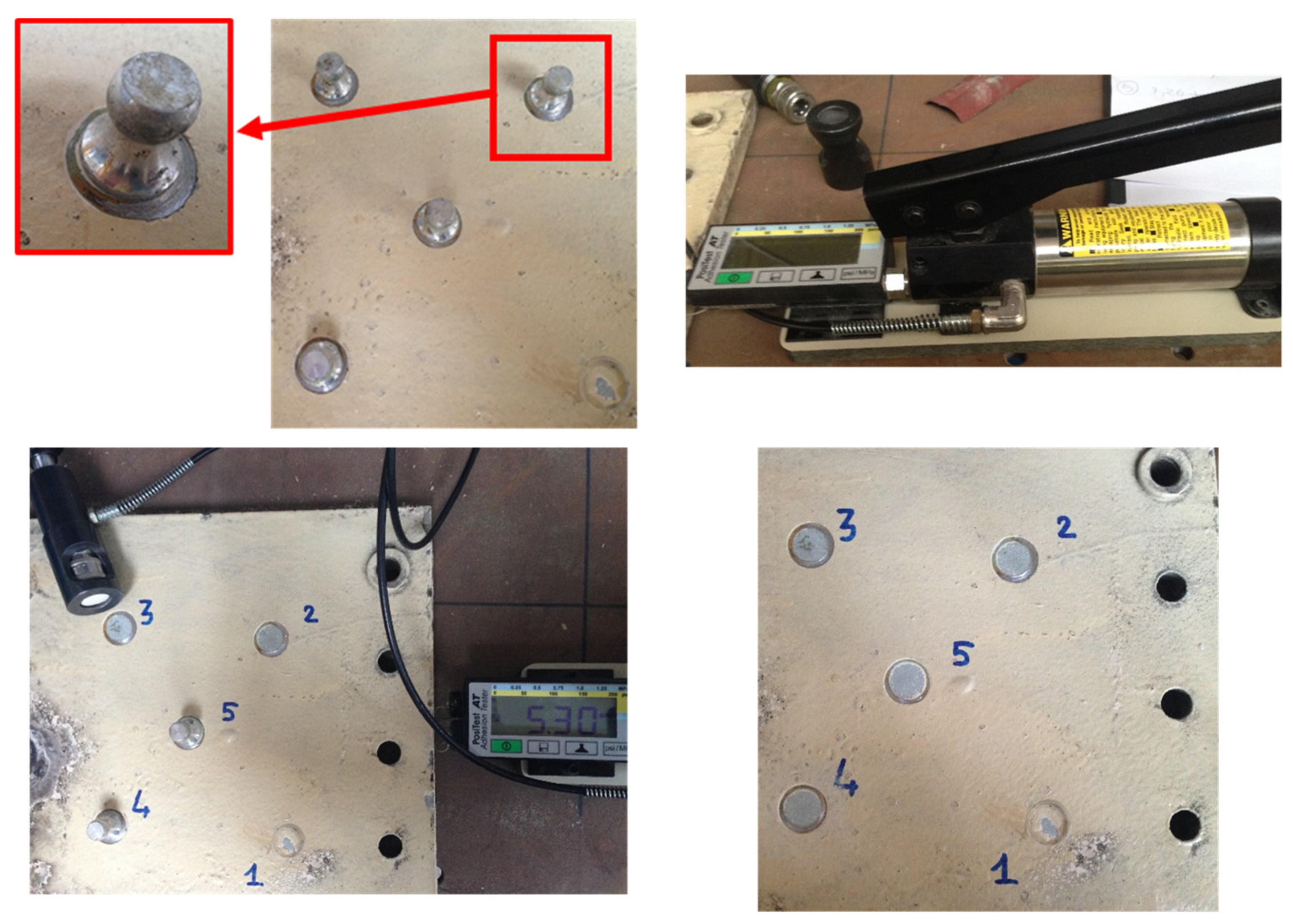

| Fire Resistance Classification | |||||||
|---|---|---|---|---|---|---|---|
| Critical temperature (°C) | 350 | 400 | 450 | 500 | 550 | 600 | 650 |
| Section factor A/V (m−1) | Thickness of IC (μm) | ||||||
| 70 | 600 | 400 | 400 | 400 | 400 | 400 | 400 |
| 75 | 600 | 400 | 400 | 400 | 400 | 400 | 400 |
| 80 | 600 | 400 | 400 | 400 | 400 | 400 | 400 |
| 85 | 600 | 400 | 400 | 400 | 400 | 400 | 400 |
| 90 | 600 | 400 | 400 | 400 | 400 | 400 | 400 |
| 95 | 750 | 400 | 400 | 400 | 400 | 400 | 400 |
| 100 | 750 | 400 | 400 | 400 | 400 | 400 | 400 |
| 105 | 750 | 400 | 400 | 400 | 400 | 400 | 400 |
Publisher’s Note: MDPI stays neutral with regard to jurisdictional claims in published maps and institutional affiliations. |
© 2022 by the authors. Licensee MDPI, Basel, Switzerland. This article is an open access article distributed under the terms and conditions of the Creative Commons Attribution (CC BY) license (https://creativecommons.org/licenses/by/4.0/).
Share and Cite
de Silva, D.; Nuzzo, I.; Nigro, E.; Occhiuzzi, A. Intumescent Coatings for Fire Resistance of Steel Structures: Current Approaches for Qualification and Design. Coatings 2022, 12, 696. https://doi.org/10.3390/coatings12050696
de Silva D, Nuzzo I, Nigro E, Occhiuzzi A. Intumescent Coatings for Fire Resistance of Steel Structures: Current Approaches for Qualification and Design. Coatings. 2022; 12(5):696. https://doi.org/10.3390/coatings12050696
Chicago/Turabian Stylede Silva, Donatella, Iolanda Nuzzo, Emidio Nigro, and Antonio Occhiuzzi. 2022. "Intumescent Coatings for Fire Resistance of Steel Structures: Current Approaches for Qualification and Design" Coatings 12, no. 5: 696. https://doi.org/10.3390/coatings12050696
APA Stylede Silva, D., Nuzzo, I., Nigro, E., & Occhiuzzi, A. (2022). Intumescent Coatings for Fire Resistance of Steel Structures: Current Approaches for Qualification and Design. Coatings, 12(5), 696. https://doi.org/10.3390/coatings12050696







